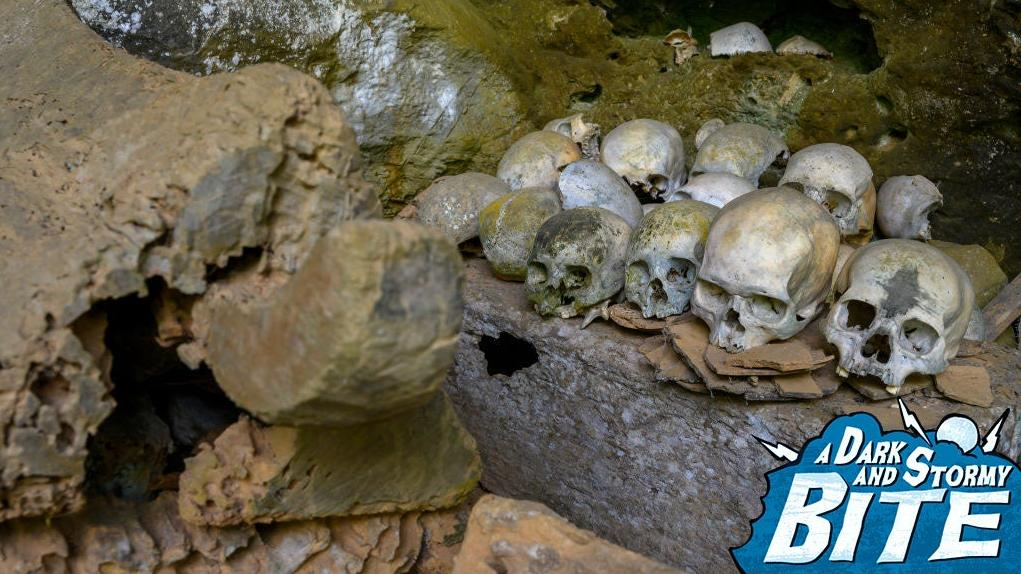This Legendary Cannibal Clan Feasted On Blood, Guts, And Anti-Scottish Sentiment
Did the Sawney Bean clan actually snack on townsfolk, or was it all anti-Scottish lore?
Welcome, foolish mortals, to the home of cadaverous casseroles, exsanguinous eats, and snack-related sagas so strange and frightening they may well transport you to a realm unknown. Welcome, readers, to A Dark and Stormy Bite, a monthly column that dives deep into a teeth-chattering culinary dimension of utterly ghoulish proportions. Basically, if it involves food and goes bump in the night, we'll cover it here. Do you have a favorite haunted restaurant or cursed recipe? Email lstone@thetakeout.com—and beware.
For some, family dinner means tucking into a juicy meatloaf or a festive taco spread. For others, it involves strings of viscera, pan-fried eyeballs, and slabs of flesh hacked directly from a dying man's thigh as he screams for mercy. It's like I always say: when you're with family, it doesn't matter what (or who) you eat—as long as it's prepared with love.
If apocrypha is to be believed, no one did family meals quite like the tight-knit Bean clan, a legendary Scottish cannibal crew led by patriarch Alexander "Sawney" Bean. I've only covered one act of cannibalism since debuting this column, but Bean and his famed taste for man meat are by far the most requested Dark and Stormy Bite subjects. Commenters, I hear you. In an effort to give the people what they want, I dove into Bean's grisly history, which is said to have inspired Wes Craven's 1977 horror flick The Hills Have Eyes. The Bean saga is certainly terrifying—but, according to my research, it may be little more than anti-Scottish propaganda spread by jittery Brits. Journey with me deep into the Bean clan's flesh cave and I'll explain.
Legend has it that Sawney Bean was born in Edinburgh, Scotland sometime in the sixteenth century. (Scottish historian Dr. Louise Yeoman told the BBC that the only contemporary record of Bean is a brief mention in a 1755 pamphlet distributed in Britain; more on that later.) The story goes that Bean started out as a good, honest day laborer, most likely working either as a tanner, a hedger, or a ditch digger. But, like so many men before him, Bean fell prey to a vicious woman with a flair for malefactions and a grade-A pair of knockers. Her name was Black Agnes Douglas, and she and Bean fell in love, slunk away from society, and shacked up in a seaside cave where they could be alone and do the things that lovers do (reading books of poetry, sharpening their fingernails into little daggers, etc.).
The cave was equipped with everything a young couple could need—I'm thinking midcentury-inspired stalactites and also maybe a breakfast nook—but it also had a series of tunnels, some over a mile in depth. With plenty of room to grow, Bean and his scary-ass lady reproduced at a truly alarming rate, sprouting a clan that eventually numbered between 45 and 50 sons, daughters, and grandchildren, with the third generation born entirely out of incest.
But how does a hardworking dad keep his gigantic, deformed clan fed and happy in their dank cave? By robbing, kidnapping, dismembering, pickling, and eating unfortunate travelers, of course. Legends vary, but the Beans are said to have cannibalized around 1,000 people over the course of a few decades. Their bone-sucking saga came to an end when one of their would-be victims managed to escape, running off to inform local magistrates of the clan's murderous deeds. Folks say that King James VI of Scotland went on to assemble 400 men and a legion of hounds to track, capture, and kill each and every Bean, leaving behind a cave full of disembodied legs, pickled intestines, and other delicacies.
It's a great bedtime story, to be sure. Fortunately (or unfortunately, depending on how macabre you are), the story is likely little more than legend. First, as Yeoman told the BBC, there are no records of the countless missing persons snatched by the Beans. Yeoman also couldn't find record of the manhunt led by King James—an event that, if it actually took place, would almost certainly be recorded for posterity.
No, the true origins of the legend are likely a bit more sinister. Yeoman argues that the tale was an English propaganda tool to disparage proud Scots, a spooky legend distributed via ghastly pamphlets in the 18th century. Quick reminder of the history of English-Scottish tensions: from William Wallace to the Jacobite uprisings, the British government spent centuries dismantling the Highlands' clan system and working to eliminate Scottish sovereignty. Also worth noting: Bean's purported lover, Black Agnes, shares a name with Agnes Randolph, Countess of Dunbar. Nicknamed "Black Agnes" for her dark hair and complexion, Randolph is known for her heroic defense of Scotland's Dunbar Castle against an English siege in 1338. Was Bean's lady cannibal so named to disparage a centuries-old Scottish heroine? Possible. Very possible. Speaking of names: While "Sawney" is traditionally a nickname for "Alexander," the term "sawney" was also an oft-derogatory nickname lodged against Scotsmen by the British.
Whether the legend of Sawney Bean is based in fact or is just a prejudiced attempt to demonize the Scottish as they attempted to establish sovereignty, you can actually visit the purported home of the Bean clan. Known as Bennane Cave, the cave is nestled just past a cluster of defunct mining towns, with a slippery entrance nearly blocked by a large boulder. If you're brave enough to sneak in, you might be greeted with a memorable spelunking experience—but if you venture deep enough inside, you might also find the remains of countless unfortunates who unwittingly made their way from traipsing the high road to adorning the dinner table.
